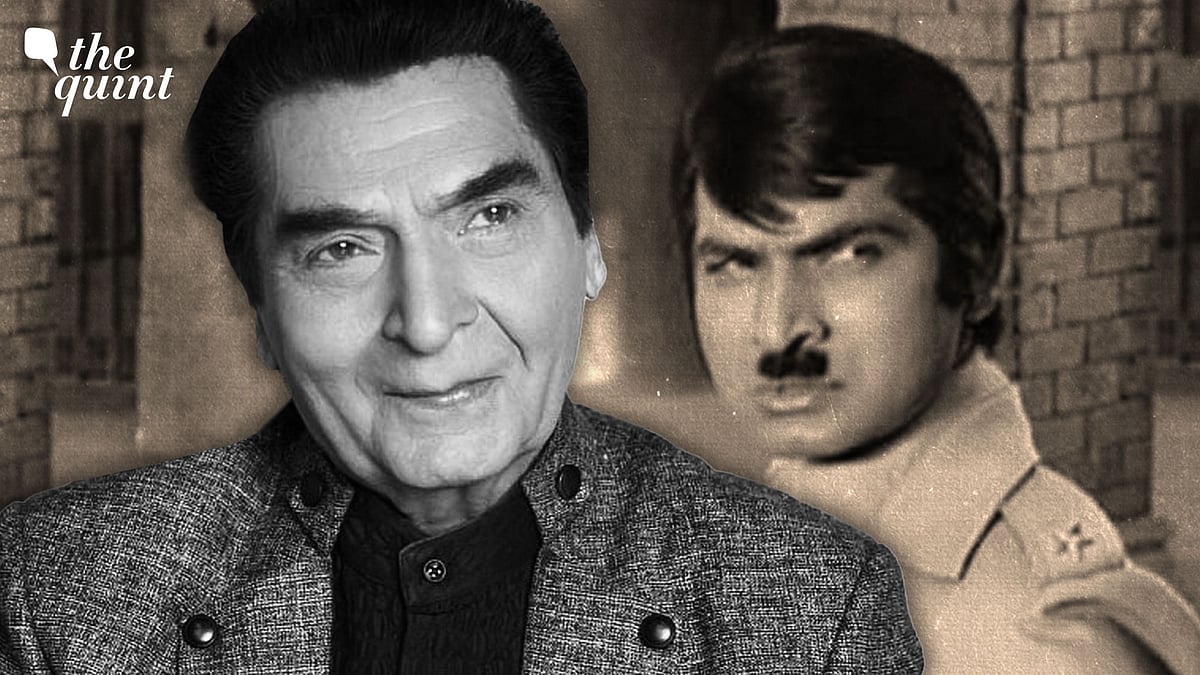Farewell Asrani, Bollywood’s Beloved Funster
From a Jaipur carpet shop to over 350 films, a tribute to the man behind the smile.

advertisement
“Who has been your favourite co-star?” I’d asked Amitabh Bachchan the predictable question in the course of an interview, circa the 1980s, to be answered quite unpredictably with a terse, “Asrani for sure.”
To the surprised look on my face, Bachchan had explained, “Take Abhimaan in which he played my secretary. Whenever there was a scene showing us in conversation in a frame, his responses were perfect, neither over nor underdone."
Asrani in a still from Abhimaan.
(Photo Courtesy: YouTube)
The Listener Who Made Us Laugh
Few had noticed that unusual trait in Govardhan Asrani who passed away on 20 October, aged 84, heartbreakingly after sharing Diwali text messages. He had been admitted to Mumbai's Arogya Nidhi Hospital for the past four days due to age-related breathing problems.
With a score of approximately 350 films primarily in Hindi and the rest in Gujarati and Punjabi, quixotically he is most famously identified by the Gen Z for his cameo as the wickedly cackling jailer of Sholay.
Asrani in a still from Sholay.
(Photo Courtesy: YouTube)
Come to think of it, he could make a lasting impact in brief pop-up roles.
Like, as a film struggler in Guddi, he had narrated how an aspiring actor would be rejected by filmmakers after countless auditions but could never return to his distant hometown in fear of being humiliated and ostracised. That he repeated this point as the protagonist subsequently in the barely remembered Chala Murari Hero Banne (written and directed by himself) was a wake-up call that he wasn’t cut out to play Hindi cinema's archetypal hero.
The Comic Who Outlasted Eras
Last seen in the web series The Trial: Season 2 (remake of the American series The Good Wife), Asrani didn’t buckle under the pressure of the iron-like strength of Kajol, his adversary lawyer in a contentious court case. His voice and carriage with the help of a walking stick retained that underlying sarcasm and wit, despite his part as a Parsi lawyer, Mr Electricwalla, bordered on the age-old representation of the minority community as a rude caricature.
Winner of two Filmfare Awards for the Best Comedian, at a time when such a category existed, for Aaj ki Taaza Khabar as a character called Champak Bhoomia and Balika Badhu, these trophies extended his longevity.
He continued to feature in the mega-garish dramedies from the southern studios in the 1970s, often teaming up to complete the mandatory comedic track as a trio with Kader Khan and Shakti Kapoor.
For starters, he had trained at the suggestion of directors Kishore Sahu and Hrishikesh Mukherjee by enrolling at the Film and Television Institute of India (FTII), Pune.
He first featured in Sahu’s Hare Kaanch ki Choodiyan as Biswajeet’s friend (euphemism for sidekick).
As laugh-raisers of immense popularity like Johnny Walker and Mehmood before him had already set a high bar, he couldn’t instantaneously become the next big thing in the constellation of the still-undervalued comic actors. In any case, the lead actors—be it Amitabh Bachchan or Dharmendra—were also incorporating the comedy ingredient into their entertainers.
Fortunately for Asrani, Hrishikesh Mukherjee, Gulzar, Basu Chatterjee, and later Priyadarshan, believed in him to the extent of creating roles that would suit his individualistic sense of timing, and occasionally, a muted trick of being expressionless a la Buster Keaton in the midst of the mayhem-like plots.
In addition, Rajesh Khanna, the superstar of the early 1970s, was impressed with Asrani's expertise when they worked together in Bawarchi that in sum, they appeared in over 20 films together.
Asrani in a still from Bawarchi.
(Photo Courtesy: YouTube)
The Man Behind the Comic Mask
Born in 1941 to a middle class Sindhi family which owned a carpet shop in Jaipur, Asrani had seven siblings. He graduated from Rajasthan University, paying for his fees by working as a voice artiste at the All India Radio in his hometown.
In the midst of his bourgeoning career, he married actor Manju Bansal whom he met on the sets of Aaj ki Taaza Khabar. In fact, the overnight marriage made front-page news, and the couple was featured on the cover of the widely circulated Filmfare magazine.
While many reports state that the couple did not have any children, other sources confirmed they have a son, Naveen Asrani, who's a dentist based in Ahmedabad.
Manju Bansal and Asrani on the cover of Filmfare.
(Photo Courtesy: Filmfare)
Indulgently, Asrani also produced and directed an oddity of a film titled Hum Nahin Sudhrenge (1980), which flopped miserably, followed by failed textile investments that caused heavy financial losses.
According to the film critics of his era, his most imperishable performances were essentially in the medium-budgeted Mere Apne, Koshish, Parichay, Abhimaan, Satyakam, Do Ladke Dono Kadke, Chhoti si Baat, Dillagi, and Pati Patni aur Woh.
A little-known fact is that he was director of the FTII from 1988 to 1993, which signified a return of the native, as it were, to his alma mater.
(Khalid Mohamed is a film critic, film director and screenwriter. He has written novels and biographies and is currently working on his memoirs of Bollywood.)